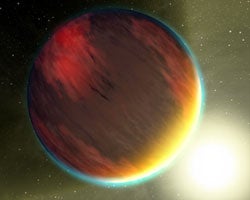Spanish and UCL (University College London) scientists have discovered a possible terrestrial-type planet orbiting a star in the constellation Leo. The new planet, which lies at a distance of 30 light-years from Earth, has a mass five times that of our planet but is the smallest found to date. One full day on the new planet would be equivalent to three weeks on Earth.
The team of astronomers from the Spanish Research Council (CSIC) working with Jean-Philippe Beaulieu, a visiting astrophysicist at UCL, made the discovery from model predictions of a new exoplanet — planet outside our solar system — orbiting a star in the constellation Leo. Simulations show that the exoplanet, dubbed GJ 436c, orbits its host star, GJ 436, in only 5.2 Earth days, and is thought to complete a revolution in 4.2 Earth days, compared to Earth’s revolution of 24 hours and full orbit of 365 days. On Earth, a full day coincides quite closely with the rotation period. On the new planet these two periods do not coincide, since the orbital translation period and the rotation period are very similar. For this reason, a full day on the new planet would take four planetary years, or roughly 22 Earth days.
The study, published this week in Astrophysical Journal, predicted the presence of a small exoplanet perturbing an inner planet (already known), producing changes on its orbit. A re-analysis of archival radial velocities also permitted the identification of a signal that perfectly matches the simulations and corresponds to a planet in resonance with the inner one, meaning that for every two orbits of the known planet the new planet completes one.
Ignasi Ribas, lead author of the study from CSIC, says, “After final confirmation, the new exoplanet will be the smallest found to date. It is the first one to be identified from the perturbations exerted on another planet of the system. Because of this, the study opens a new path that should lead to the discovery of even smaller planets in the near future, with the goal of eventually finding worlds more and more similar to the Earth.”
Beaulieu says, “This is the fourth super-Earth planet discovered. This planet is the hot twin of the frozen super-Earth (OGLE-2005-BLG-390lb) we discovered by microlensing 2 years ago. Other previously discovered planets of this class are the two hot super-Earths Gl 581b and Gl 876d detected by their Doppler wobble.”
Giovanna Tinetti, UCL Physics and Astronomy who recently calculated the putative properties of this planet, says, “Calculations indicate that the temperature of the planet could be within 400-700 Kelvin (127-427 Celsius), but it could locally be as low as 350 Kelvin (77 C) at the poles, depending on the type of atmosphere.”
Most of the 280 or so planets discovered to date are gas giants similar to Jupiter, although some with masses below 10 times that of the Earth have already been found. Planets with masses of between one and 10 times the Earth are often dubbed super-Earths. In this case, current models predict that the new planet is a rocky type and has a radius some 50 percent larger than the Earth.










